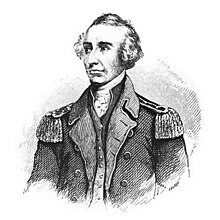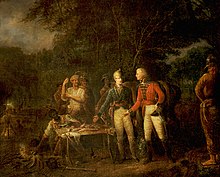Francis Marion
Francis Marion (born February 26, 1732 in Georgetown , Province of South Carolina , † February 27, 1795 ibid) was a lieutenant colonel in the Continental Army and later a brigadier general in the South Carolina militia during the American Revolutionary War . Before the War of Independence he was a seaman. Due to his ability to use decoy and ambush tactics to disrupt enemy communications, to cut off supplies and to free prisoners of war, he was nicknamed "Swamp Fox". Since his opponents only knew the open battlefield, he set new standards in warfare with his use of guerrilla tactics .
Marion is considered one of the founders of modern guerrilla warfare and is seen as a co-founder of the US Rangers .
Origin and early life
The Marion family came from Huguenots . His parents were Gabriel Marion and Esther Cordes Marion. His grandparents were Benjamin and Judith Baluet Marion and Anthony and Esther Baluet Cordes. Gabriel and Esther had six children: Esther, Isaac, Gabriel, Benjamin, Job and Francis. Francis was the last born and was considered a rather weak child. They settled near Winyah near Georgetown, where Francis Marion was born in the winter of 1732 on the Gayfield Plantation in St. James, a parish in Berkley, South Carolina. In 1739/40 his family moved from Gayfield to a plantation in St. George, a community in Winyah Bay, because they apparently wanted to settle near the English school in Georgetown. In 1759 he moved to the Pond Bluff Plantation near Eutaw Springs in South Carolina (now Eutawville ). Marion was fluent in French and English.
When Marion was 15 he decided to become a seaman. He signed as the sixth crew member on a schooner for the passage to the West Indies . While they were driving back, a whale rammed the schooner and they were shipwrecked and did not reach land until the 7th day on the lifeboat. Peter Horry, who examined Marion, described his health as completely changed for the better. Marion then gave up the seaman profession.
Marion began his military career shortly before his 25th birthday. On January 1, 1757, he and his brother Gabriel were recruited by Captain John Postell to fight the Cherokee Indians on the border in the French and Indian War. Marion served as a lieutenant under Captain William Moultrie in the fighting against the Cherokees in 1761. Marion always remained the polite gentleman, striving to be considered better than the British officers.
Revolutionary years
In 1775 he was a member of the South Carolina Provincial Congress and on June 21, 1775 he was appointed captain in the 2nd South Carolina Regiment under William Moultrie , with whom he defended the two forts Fort Sullivan and Fort Moultrie in June 1776 in the harbor from Charleston took over.
In September 1776, the Continental Congress promoted Marion to lieutenant colonel. In the fall of 1779 he took part in the siege of Savannah and in the spring of 1780, under the command of General Benjamin Lincoln, he trained the militia forces.
Marion escaped Charleston's surrender on May 12, 1780 because he broke his ankle in an accident and left town to recover. After the surrender of Charleston, the lost battle of General Isaac Huger at Moncks Corner and the defeat of Lieutenant Colonel Abraham Buford in the Waxhaw massacre , Marion organized a small force that initially consisted of 20 men and later grew to 70. He only wanted to attack the British in their own territory and state. At this point he was still hampered by his slowly healing ankle.
He joined General Horatio Gates shortly before the Battle of Camden , but Gates had no confidence in him and sent him to take command of the Williamsburg Militia in the Pee Dee area. He was also supposed to take up scouting missions and prevent the expected withdrawal of the British after the battle. Marion freed 150 prisoners of war and captured twenty British soldiers. The freed prisoners joined Marion and his militiamen.
Unlike the continental troops, Marion's men served voluntarily, owned their own horses, and procured their own food and other supplies, often through spoils of war from the British. Marion rarely led his men in frontal attacks, but he repeatedly surprised larger units of Loyalists or British soldiers with quick attacks and disappeared again just as quickly. The British were driven out while trying to occupy the Williamsburg garrison near Willtown by Marion at the Battle of Mingo Creek.
British Colonel Banastre Tarleton was sent to arrest Marion but was desperate to find the "old swamp fox" who kept avoiding him as he traveled along the swamp paths. Tarleton and Marion differed markedly in public opinion. Tarleton was hated for burning and destroying homes and supplies, while Marion's men confiscated or destroyed the supplies so as not to fall into British hands and gave supply certificates to the owners. After the war, most of these supply certificates were redeemed by the new government.
Once Marion had demonstrated his skill in guerrilla warfare, he posed an annoying threat to the British. Governor John Rutledge promoted him to brigadier general of the state troops. When General Nathanael Greene took command in the south, he ordered Brigadier General Marion and Lieutenant Colonel Henry Lee to attack Georgetown in January 1781. However, this failed. However, they captured Fort Watson in April and Fort Motte in May, cutting off communications between the British posts in Carolina. On August 31, 1781, Marion rescued a small American force trapped by 500 British under Major C. Fraser. For this deed he received the thanks of the Continental Congress. Marion commanded the right flank under General Greene's command at the Battle of Eutaw Springs.
In 1782, during his absence as a Senator in Jacksonborough, his brigade was discouraged and there was allegedly a conspiracy to extradite him to the British. But in June of that year he put down a loyalist uprising on the banks of the Pee Dee River. In August 1782 he left his brigade and returned to his plantation. After the war, Marion married his cousin, Mary Esther Videau. Marion served in the South Carolina Senate for a number of terms and was appointed Commandant of Fort Johnson in 1784 in recognition of his services, more of a courtesy title with a salary of $ 500 a year (originally he was supposed to receive a multiple of £ 500 a year) . He died on his country estate in 1795.
Film adaptations
The Hollywood film The Patriot (2000) is very loosely based on Marion's biography. The protagonist "Colonel Benjamin Martin", played by Mel Gibson, was a mixture of General Marion, General Andrew Pickens, Colonel Thomas Sumter and Colonel Daniel Morgan from Virginia. His counterpart in this film is also loosely based on the person of British Colonel Banastre Tarleton .
dig
His headstone in Belle Isle Plantation Cemetery in County Berkeley, South Carolina reads:
In the spirit of memory of GENL. FRANCIS MARION, who left this life on February 27, 1795, in the 63rd year of his life, deeply deplored by all his acquaintances. History marks him as one of the most remarkable PATRIOTS AND HEROES OF THE AMERICAN REVOLUTION. The prestige that he brought to his home state was honor and independence, and the blessings consolidated in freedom and peace. This monument of gratitude is erected in memory of the noble and selfless virtues of the citizen and the valiant exploits of the soldier who lived without fear and died without reproach.
Afterlife
16 counties in the United States are named after Marion .
literature
- William Willis Boddie: Traditions of the Swamp Fox. William W. Boddie's Francis Marion. Reprint Co., Spartanburg SC 2000, ISBN 0-87152-528-3 .
- WG Simms: The Life of Francis Marion. New York, 1833.
- Jonathan Myers: Swamp Fox. Birth of a Legend. Ambition Studios, Apalachin NY 2003, ISBN 0-9746000-0-8 .
Web links
- Francis Marion in the database of Find a Grave (English)
- Gutenberg Text
Individual evidence
- ↑ co.berkeley.sc.us ( Memento of the original from October 7, 2006 in the Internet Archive ) Info: The archive link was inserted automatically and has not yet been checked. Please check the original and archive link according to the instructions and then remove this notice.
- ^ Francis Marion in the Find a Grave database . Retrieved January 9, 2015.
- ↑ Charles Curry Aiken, Joseph Nathan Kane: The American Counties: Origins of County Names, Dates of Creation, Area, and Population Data, 1950-2010 . 6th edition. Scarecrow Press, Lanham 2013, ISBN 978-0-8108-8762-6 , p. Xiv.
| personal data | |
|---|---|
| SURNAME | Marion, Francis |
| ALTERNATIVE NAMES | Swamp fox (nickname) |
| BRIEF DESCRIPTION | Continental Army officer |
| DATE OF BIRTH | February 26, 1732 |
| PLACE OF BIRTH | Georgetown , South Carolina |
| DATE OF DEATH | February 27, 1795 |
| Place of death | Georgetown , South Carolina |

